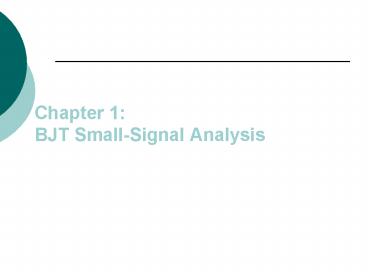Chapter 1: BJT SmallSignal Analysis PowerPoint PPT Presentation
1 / 57
Title: Chapter 1: BJT SmallSignal Analysis
1
Chapter 1BJT Small-Signal Analysis
2
Contents
- Common-Emitter fixed-bias configuration
- Voltage divider bias
- CE Emitter bias
- Emitter-follower configuration
- Common-base configuration
- Collector-feedback configuration
- Hybrid equivalent circuit and model
- Effect of Rs and RL
3
BJT Small Signal Analysis
- re transistor model employs a diode and
controlled current source to duplicate the
behavior of a transistor in the region of
interest. - The re and hybrid models will be used to analyze
small-signal AC analysis of standard transistor
network configurations. - Ex Common-base, common-emitter and
common-collector configurations. - The network analyzed represent the majority of
those appearing in practice today.
4
AC equivalent of a network is obtained by
- Setting all DC sources to zero
- Replacing all capacitors by s/c equiv.
- Redraw the network in more convenient and logical
form
5
(No Transcript)
6
(No Transcript)
7
(No Transcript)
8
Common-Emitter (CE) Fixed-Bias Configuration
The input (Vi) is applied to the base and the
output (Vo) is from the collector. The
Common-Emitter is characterized as having high
input impedance and low output impedance with a
high voltage and current gain.
9
Removing DC effects of VCC and Capacitors
10
re Model
Determine ?, re, and ro ? and ro look in the
specification sheet for the transistor or test
the transistor using a curve tracer. re calculat
e re using dc analysis
11
Impedance Calculations
Input Impedance Output Impedance
12
Gain Calculations
Voltage Gain (Av) Current Gain
(Ai) Current Gain from
Voltage Gain
13
Phase Relationship
The phase relationship between input and output
is 180 degrees. The negative sign used in the
voltage gain formulas indicates the inversion.
14
CE Voltage-Divider Bias Configuration
15
re Model
You still need to determine ?, re, and ro.
16
Impedance Calculations
Input Impedance Output Impedance
17
Gain Calculations
Voltage Gain (Av) Current
Gain (Ai) Current Gain
from Voltage Gain
18
Phase Relationship
A CE amplifier configuration will always have a
phase relationship between input and output is
180 degrees. This is independent of the DC bias.
19
CE Emitter-Bias Configuration
Unbypassed RE
20
re Model
Again you need to determine ?, re.
21
Impedance Calculations
Input Impedance Output Impedance
22
Gain Calculations
Voltage Gain (Av)
Current Gain (Ai) Current
Gain from Voltage Gain
or
23
Phase Relationship
A CE amplifier configuration will always have a
phase relationship between input and output is
180 degrees. This is independent of the DC bias.
24
CE Emitter-Bias Configuration
Bypassed RE This is the same
circuit as the CE fixed-bias configuration and
therefore can be solved using the same re model.
25
Emitter-Follower Configuration
You may recognize this as the Common-Collector
configuration. Indeed they are the same circuit.
Note the input is on the base and the output is
from the emitter.
26
re Model
You still need to determine ?, re, and ro.
27
Impedance Calculations
Input Impedance
28
Impedance Calculations (contd)
Output Impedance
29
Gain Calculations
Voltage Gain (Av) Current
Gain (Ai) Current Gain from Voltage
Gain
30
Phase Relationship
A CC amplifier or Emitter Follower configuration
has no phase shift between input and output.
31
Common-Base (CB) Configuration
The input (Vi) is applied to the emitter and the
output (Vo) is from the collector. The
Common-Base is characterized as having low input
impedance and high output impedance with a
current gain less than 1 and a very high voltage
gain.
32
re Model
You will need to determine ? and re.
33
Impedance Calculations
Input Impedance Output Impedance
34
Gain Calculations
Voltage Gain (Av) Current Gain
(Ai)
35
Phase Relationship
A CB amplifier configuration has no phase shift
between input and output.
36
CE Collector Feedback Configuration
This is a variation of the CE Fixed-Bias
configuration.
37
re Model
You will need to determine ? and re.
38
Impedance Calculations
Input Impedance Output Impedance
39
Gain Calculations
Voltage Gain (Av) Current Gain
(Ai)
40
Phase Relationship
This is a CE amplifier configuration therefore
there is a 180-degree phase shift between input
and output.
41
Approximate Hybrid Equivalent Circuit
The h-parameters can be derived from the re
model hie ?re hib re hfe ? hfb
-? hoe 1/ro The h-parameters are also found in
the specification sheet for the transistor.
42
(No Transcript)
43
(No Transcript)
44
CE Fixed-Bias Configuration
45
Hybrid Equivalent Circuit
Impedances Gain
46
CE Voltage-Divider Configuration
47
Hybrid Equivalent Circuit
Impedances Gain
48
CE Unbypassed Emitter-Bias Configuration
49
Hybrid Equivalent Circuit
Impedances Gain
50
CC or Emitter-Follower Configuration
51
Hybrid Equivalent Circuit
Impedances Gain
52
CB Configuration
53
Hybrid Equivalent Circuit
Impedances Gain
54
Summary Table
55
Summary Table
56
Troubleshooting
1. Check the DC bias voltages if not correct
check power supply, resistors, transistor. Also
check to ensure that the coupling capacitor
between amplifier stages is OK. 2. Check the AC
voltages if not correct check transistor,
capacitors and the loading effect of the next
stage.
57
Practical Applications
Audio Mixer Preamplifier Random-Noise
Generator Sound Modulated Light Source

